|
|
|
MITSUBISHI LANCER EVOLUTION VII(EVO 7)
1:18 AUTOART
Year/Anno :2001
Color : Yellow - Giallo
My rating/Mio Voto : 90/100
Value for Money/Rapporto qualità prezzo : 89/100
Original price/Prezzo D'acquisto : 100 €uro (2012)
Code:77161
Clicca le F40 sul banner in alto per tornare alla Homepage e visionare altri modelli.
Click on the F40 banner on the top of this page to return at the Homepage and see all the other models of my collection.
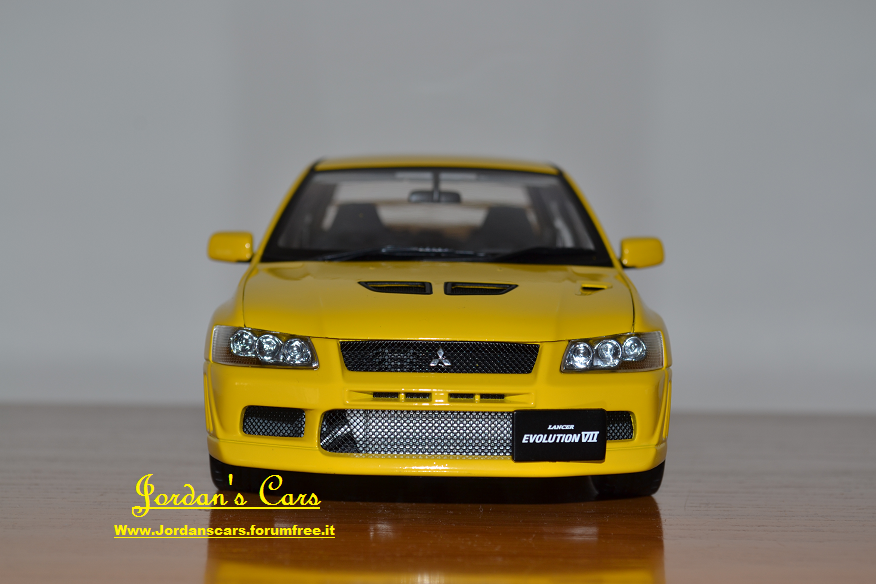
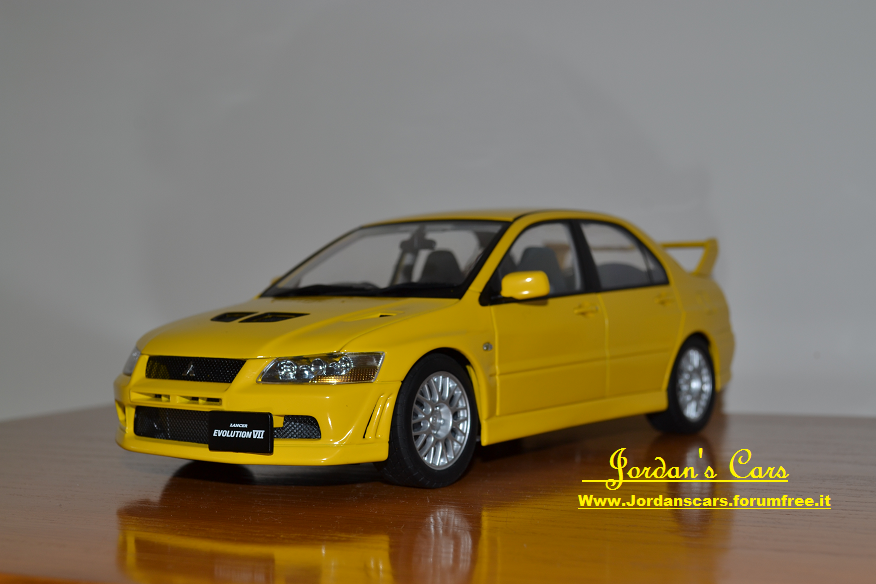
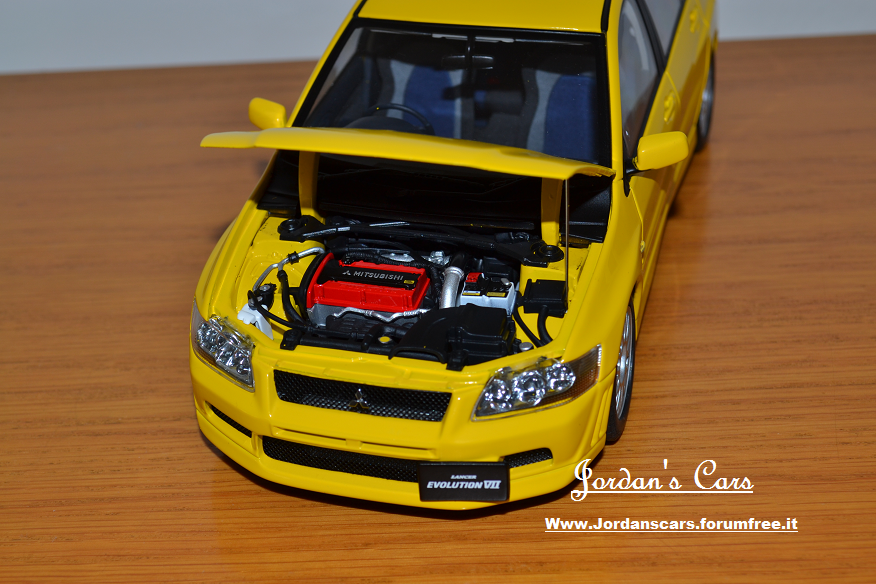
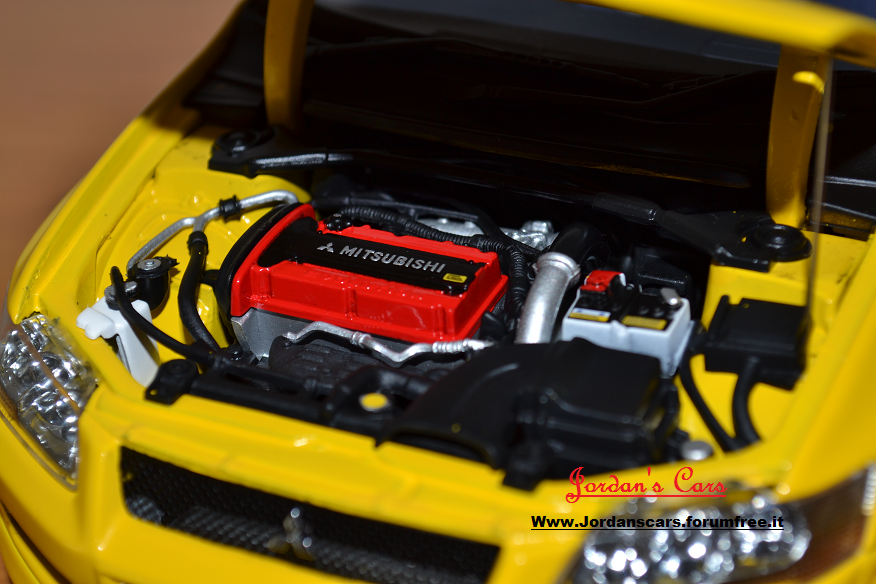
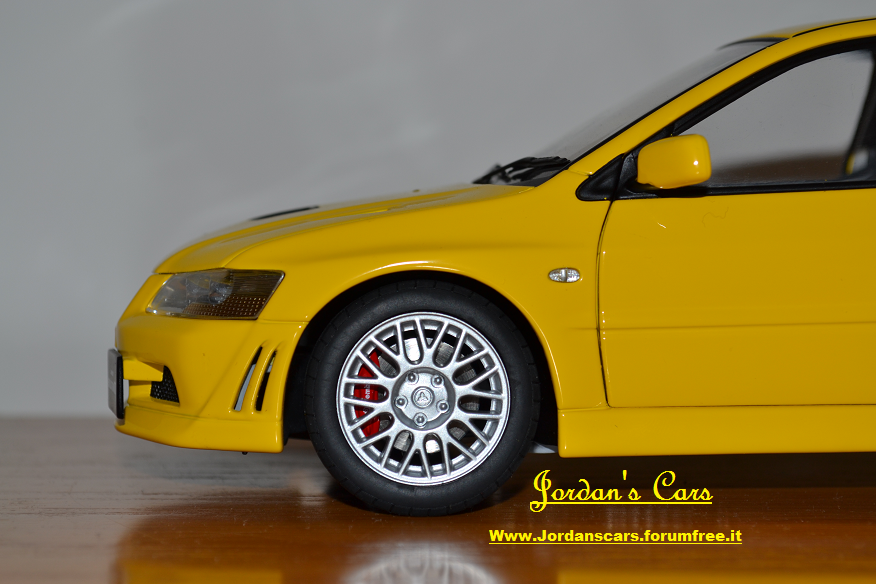
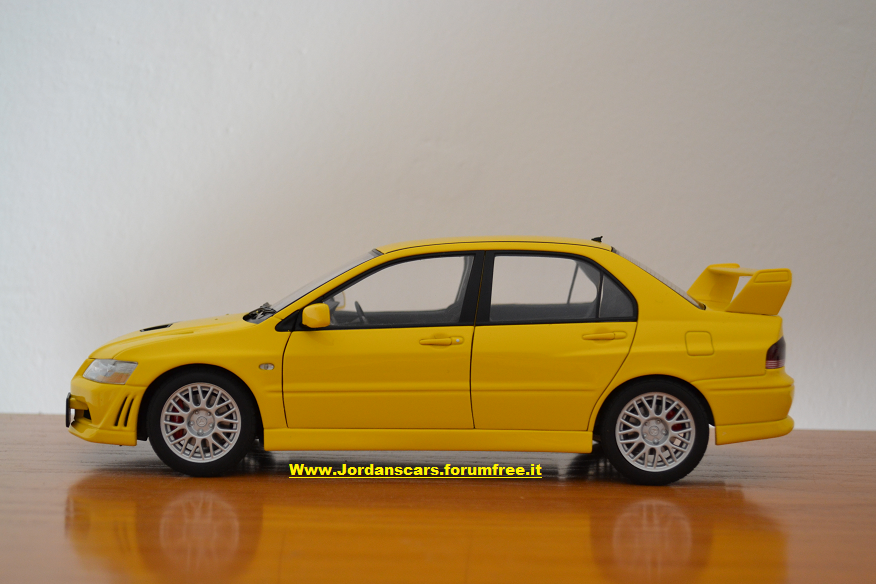
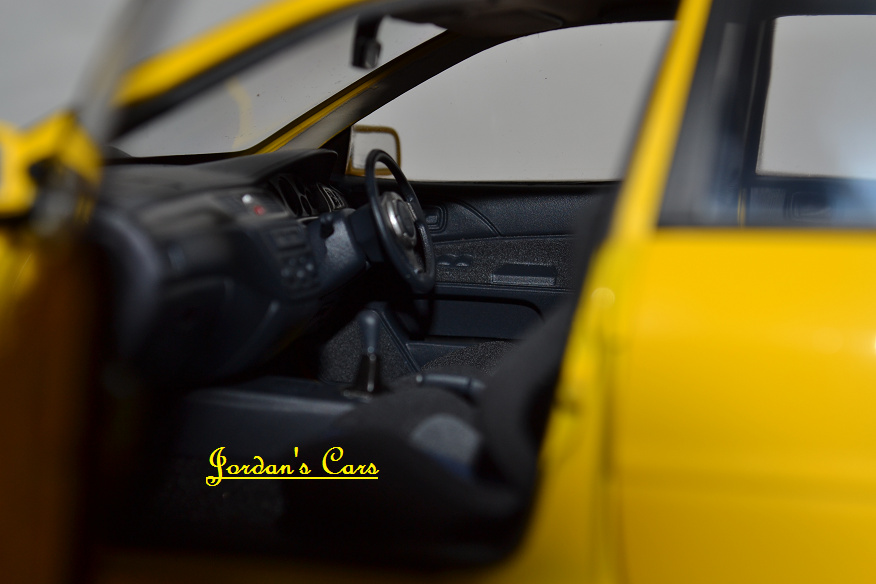
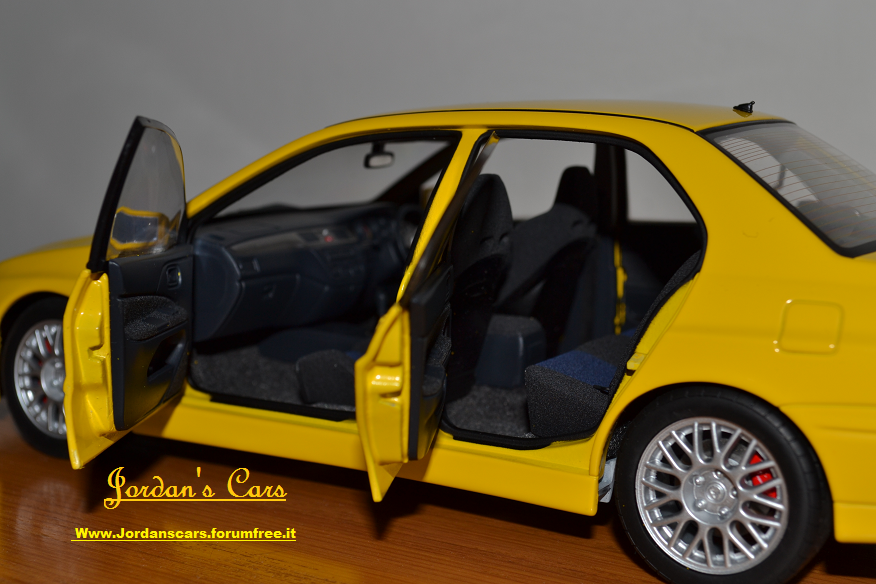
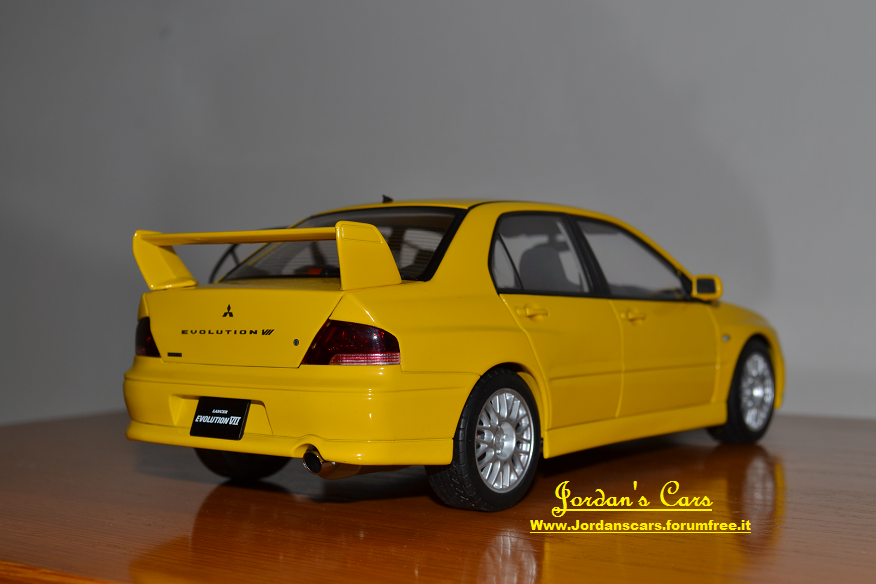
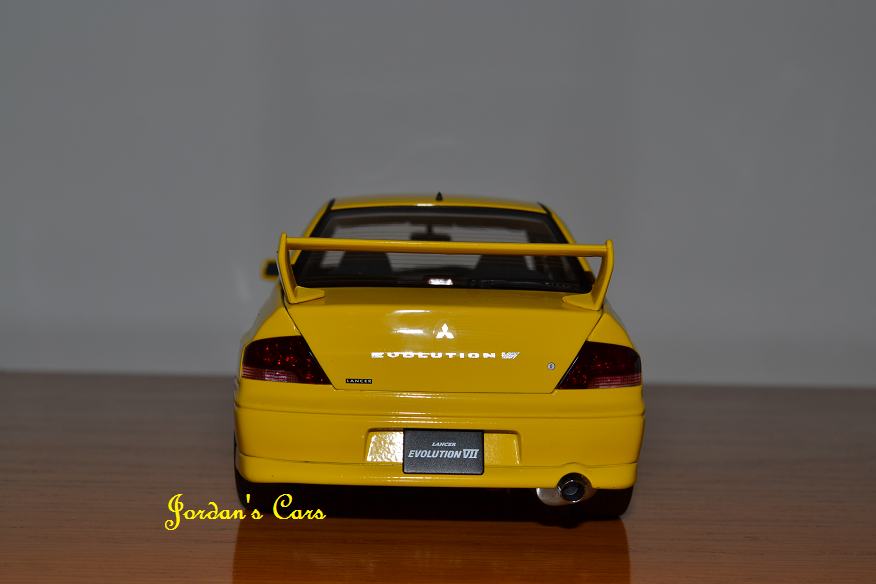
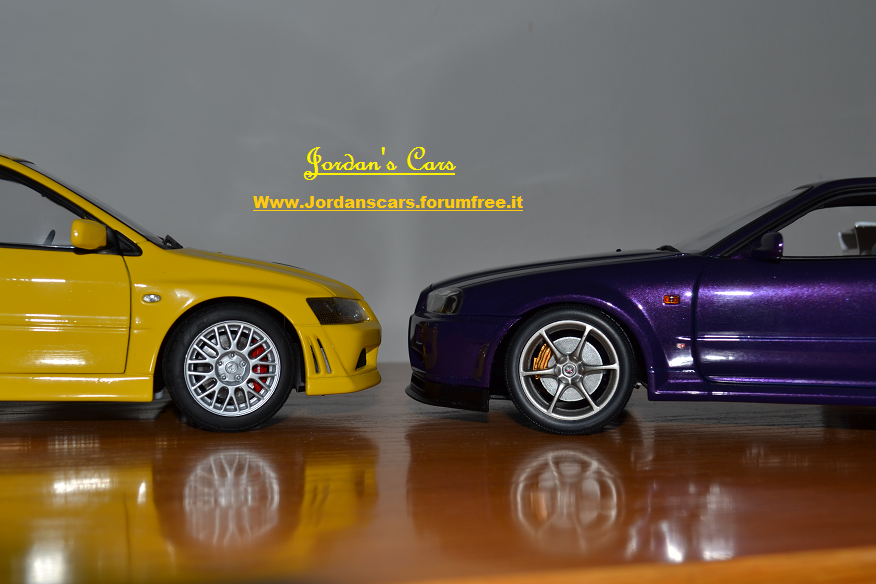
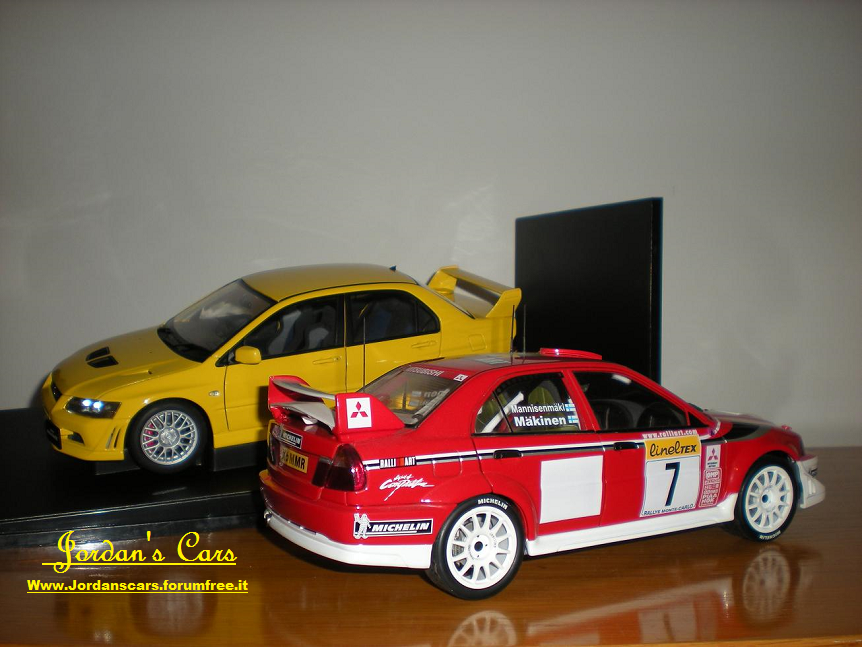
Storia dell'auto(Wiki):
La Mitsubishi Lancer Evolution, nota anche come Lancer Evo o semplicemente Evo, è la versione corsaiola della Mitsubishi Lancer prodotta dal 1992 dalla Mitsubishi Motors Corporation. Ne sono state prodotte ben dieci versioni, e la designazione numerica è data da un numero romano. I modelli Evolution fino al V erano la base della vettura da rally con la quale Mitsubishi correva nel Gruppo A del WRC. Proprio per adattarsi ai regolamenti vigenti, la versione da rally preparata dalla Ralliart, era basata sulla stradale, anche se in realtà la scocca era l'unica cosa che le accomunava.
Originalmente, la Lancer Evolution doveva essere venduta solo per il mercato interno giapponese, solo successivamente (a partire dalle versioni V e VI) venne esportata nei mercati esteri europei, dato anche il buon numero di vetture che venivano importate da questi mercati. Con la Evo VIII, il mercato della Lancer si espanse anche negli USA, dove poco tempo prima era giunta la rivale Impreza con la versione WRX STi.
Le Lancer Evolution furono decisamente competitive nel mondiale Rally, tanto da vincere 1 titolo Costruttori (1998) e 4 titoli piloti (1996-1999) grazie anche alla destrezza al volante di Tommi Makinen. Successivamente sono state sostituite nel WRC dai prototipi WRC04 e WRC05, senza peraltro ottenere successi di rilievo. Tuttavia, Lancer gareggia ancora nei campionati Gruppo N nazionali e internazionali.
La Lancer Evolution I nacque nel 1992 per competere nel Mondiale Rally. Era dotata di un motore 4 cilindri in linea, con una cilindrata 2,0 litri, dotato di distribuzione a doppio albero a camme in testa, sovralimentato tramite turbocompressore, ed utilizzava la trazione 4x4 della Galant adattata al telaio della Lancer. Le versioni disponibili erano due: la GSR e la RS, che era la "prontocorsa", privata di ogni comfort per limitare al massimo il peso (inferiore di 70 kg rispetto alla più equipaggiata GSR). Il motore, denominato dalla Mitsubishi 4G63, esprimeva 250 CV e 309 N·m di coppia motrice. Assieme alla trazione 4x4, diventerà uno dei marchi di fabbrica del modello Evolution.
La prima Evolution fu venduta in circa 5.000 esemplari.
LANCER EVO VII : Per poter continuare a gareggiare nel WRC, la Mitsubishi nel 2001 fu costretta a seguire le regole di omologazione WRC e non più del Gruppo A. MMC decise di utilizzare il pianale della Lancer Cedia, più grande rispetto al precedente. Questo causò ovviamente un aumento di peso e una maggior rigidità del telaio. Il più grande cambiamento fu però l'adozione di un differenziale centrale attivo elettronico (ACD) selezionabile dal cruscotto nelle modalità tarmac, gravel, snow (asfalto, sterrato, neve) e un più efficiente differenziale a scorrimento limitato, mentre all'anteriore fu adottato un differenziale elicoidale.Era presente l'AYC al differenziale posteriore in alcune versioni (Active Yaw Control,controllo attivo dell'imbardata). La coppia fu incrementata nuovamente fino a raggiungere il ragguardevole valore di 385 N·m, mentre la potenza rimase ufficialmente invariata a 280 CV. Su determinate prove su strada, la Evo VII era in grado di tener testa a diverse supercar, soprattutto in condizioni stradali favorevoli come strade di montagna o le cosiddette "tutte curve". La Evo VII vide per la prima volta l'introduzione di un cambio automatizzato nella versione denominata GT-A che era caratterizzata anche da diverse modifiche estetiche, la più evidente delle quali era l'adozione di un alettone posteriore di dimensioni ben più piccole rispetto alla GSR e che verrà ripreso anche nella Evo VIII da 265 CV (la versione Europea). Anche la presa d'aria anteriore sul cofano era sparita, e i fanali anteriori furono leggermente modificati. Gli interni prevedevano diversi optional di valore, come i sedili Recaro in pelle o maniglie cromate alle porte (di serie), un differente pannello degli strumenti che permetteva anche di vedere la marcia selezionata. La GT-A aveva anche diversi pannelli fonoassorbenti installati dalla Mitsubishi per un maggiore comfort acustico. Il cambio automatico a 5 marce, denominato dalla Mitsubishi "fuzzy logic" si adattava, secondo la casa, allo stile di guida del pilota, variando la scalata e la salita delle marce di volta in volta. Era comunque possibile selezionare le marce manualmente tramite dei paddles dietro al volante o alla leva tradizionale. La potenza di questa versione era diminuita, a causa dell'adozione dell'automatico, di circa 5 CV.
________________________________________________________
The Mitsubishi Lancer Evolution, also known as the Lancer Evo, Lan Evo, or just Evo, is a high performance sports sedan manufactured by Mitsubishi Motors that is based on the normal Lancer. There have been ten official versions to date, and the designation of each model is most commonly a Roman numeral. All use two litre, turbocharged engines and all-wheel drive systems.
The Evolution was originally intended only for Japanese markets, but demand on the "grey import" market led the Evolution series to be offered through Ralliart dealer networks in the United Kingdom and in various European markets from around 1998. Mitsubishi decided to export the eighth generation Evolution to the United States in 2003 after witnessing the success Subaru had in that market with their long-time direct rival, the Subaru Impreza WRX STi.
Japanese-spec cars were limited by a gentlemen's agreement to advertise no more than 280 PS (206 kW; 276 hp), a mark already reached by Evolution IV. Therefore, each subsequent version has unofficially evolved above the advertised power figures, with the Japanese-spec Evolution IX reaching an alleged output of around 321 PS (236 kW; 317 hp). Various versions available in other markets, particularly the UK, have official power outputs up to 446 PS (328 kW; 440 hp).
The tenth and final generation of the Lancer Evolution was launched in Japan 2007, and overseas markets in 2008.
EVO VII: In 2001, Mitsubishi was forced by the FIA to race in the WRC using WRC rules for building a car instead of the Group A class rules, and thus did not need to follow homologation rules. The Evolution VII was based on the larger Lancer Cedia platform and as a result gained more weight over the Evolution VI, but Mitsubishi made up for this with multiple important chassis tweaks. The biggest change was the addition of an active center differential and a more effective limited-slip differential, while a front helical limited-slip differential was added. Torque was increased again to 385 N·m (284 lb·ft) with engine tweaks that allowed greater airflow, and horsepower officially remained at 280 PS (206 kW; 276 hp).
The introduction of the Evolution VII also marked the first time an automatic drivetrain was included within the model lineup—the GT-A. Seen as the 'gentleman's express' version of the visually similar VII GSR and the RS2, the GT-A model was only produced in 2002 and had the following distinguishing interior and exterior specification: GT-A-only diamond cut finish 17-inch (430 mm) alloy wheels, clear rear light lenses and all-in-one style front headlights (later used on the Evolution VIII). The GT-A had the option of either no spoiler, the short spoiler (as per the Lancer Cedia; and later used on the Evolution VIII 260) or the thunderspoiler as used on the standard Evolution VII models. The most distinguishing feature was a smooth bonnet with no air-grills on it at all and the revised front bumper. Although offering inferior cooling capabilities, the bonnet was designed to give a cleaner line through the air with less air resistance at motorway speeds.
Interior could be specified with factory options of a deluxe velour interior, full leather or the Recaro sports seats. The GT-A interior was different in that it had chromed door handles, a different instrument panel (to show the gear selection) and chrome edged bezels around the speedo and tach. The GT-A also had additional sound deadening installed from the factory and the engine manifold and downpipe had been engineered to be quieter.
The 5-speed automatic gearbox had what Mitsubishi called "fuzzy logic", which meant that the car would learn what the driver's driving characteristics were like and would adapt the gear change timings and kick down reactions accordingly. The gears could be manually selected as with most Tiptronics via steering wheel + and – buttons (a pair both sides) or via selecting the tiptronic gate with the gear lever. Power was down a little from the standard manual cars with 272 PS (200 kW; 268 hp). The GT-A gearbox did not appear again in the Evolution VIII but has been installed in the estate version of the Evolution IX Wagon. It was replaced by the Twin Clutch SST gearbox since the introduction of Evolution X.

Modelli correlati / Related model cars:
NISSAN SKYLINE R34 ---> https://jordanscars.forumfree.it/?t=69538201
SUBARU IMPREZA WRC'99 ---> https://jordanscars.forumfree.it/?t=70418184
|
|



















